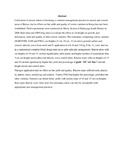Effect Of Ratooning On Growth, Lint Yield And Quality Of Cotton In Mwea, Kirinyaga South District

View/
Date
2011Author
Macharia, J.M.K.
Chemining’wa, G.N.
Kinama, J.M.
Type
PresentationLanguage
enMetadata
Show full item recordAbstract
Cultivation of ratoon cotton is becoming a common management practice in eastern and coastal
areas of Kenya, but its effects on lint yield and quality of cotton varieties in Kenya has not
been established. Field experiments were conducted in Mwea divison of Kirinyaga South
District in 2008 short rains and 2009 long rains to evaluate the effect of cut-height on
growth, pest infestation, yield and quality of three cotton varieties. The treatments
comprising cotton varieties (HART89M, A540 and F962), cut-heights (5 cm, 10 cm, 15 cm
above ground surface and control- directly sown from seed) and N application levels (0 and
110 kg N ha -1), were laid out in a randomized complete block design laid out as split-split
plot arrangement. Ratoon plots with cut-heights of 10 and 15 cm had significantly taller
plants and higher number of stems/plant than 5 cm cut-height ratoon plots and directly sown
control plots. Ratoon crops with cut-heights of 15 and 10 cm had significantly higher lint
yield and percentage of grade ‘AR’ lint than 5 cm cut-height ratoon and control plots.
Nitrogen application had no effect on lint yield and quality. Ratoon crops suffered early
attacks by aphids, mites, mealybugs and stainers. Variety F962 had higher lint percentage
yield than the other varieties. Farmers can obtain better yields with ratoon crops of 10 and
15 cm cut-heights than crops directly sown from seed, but ratooning cotton can only be
sustainable with appropriate pest management practices.
